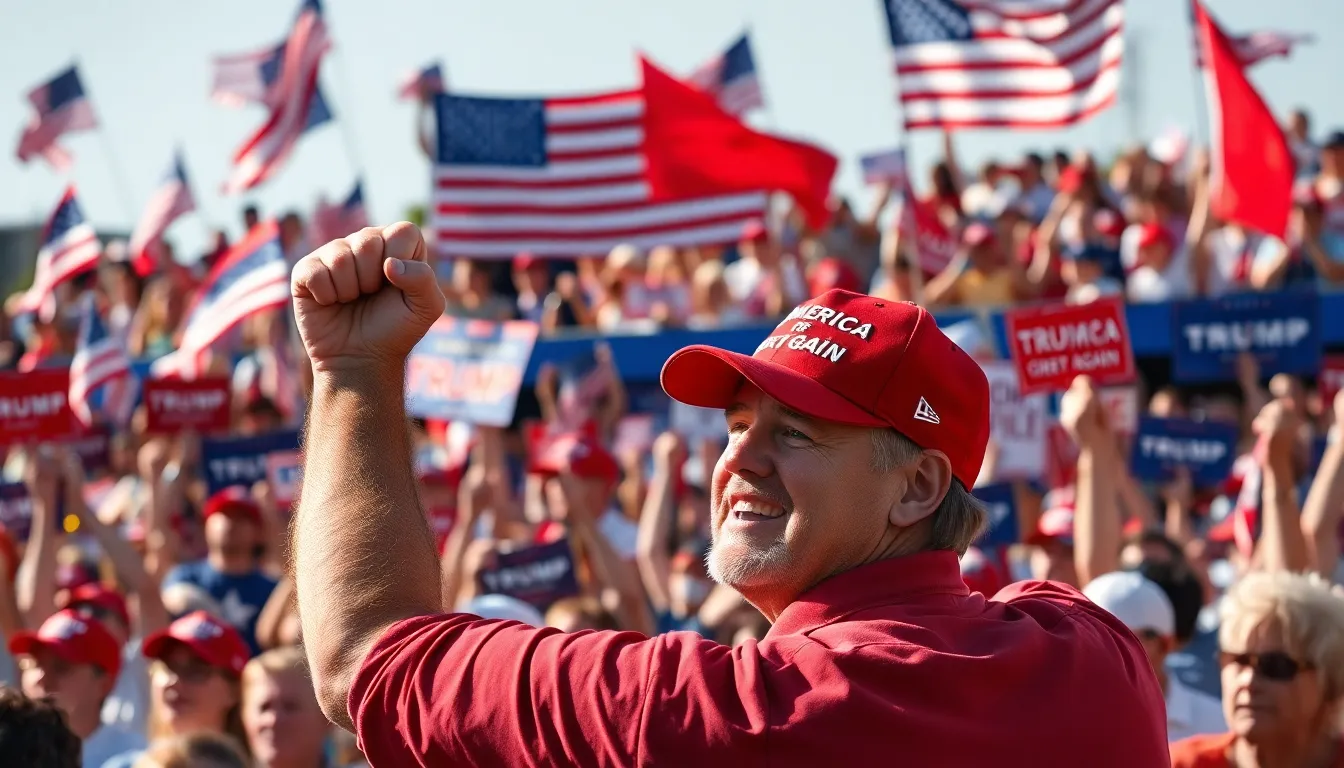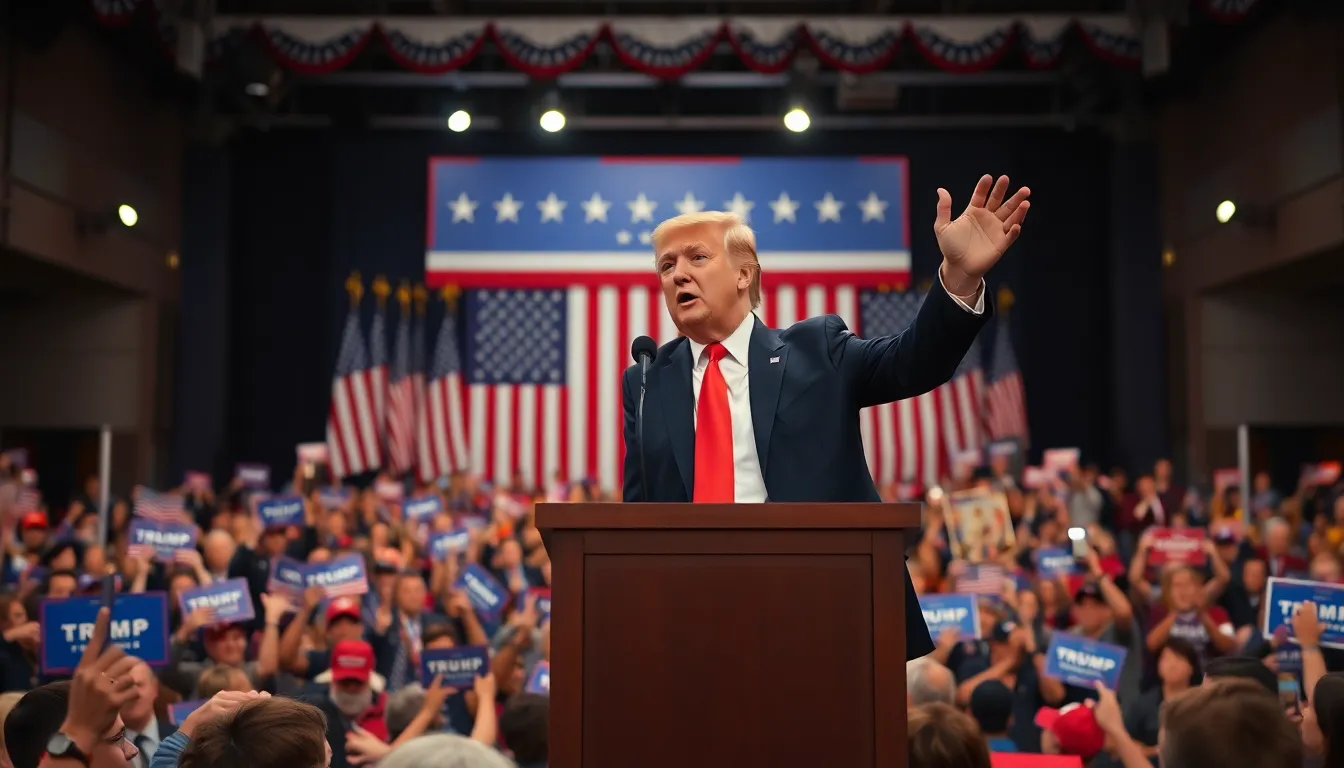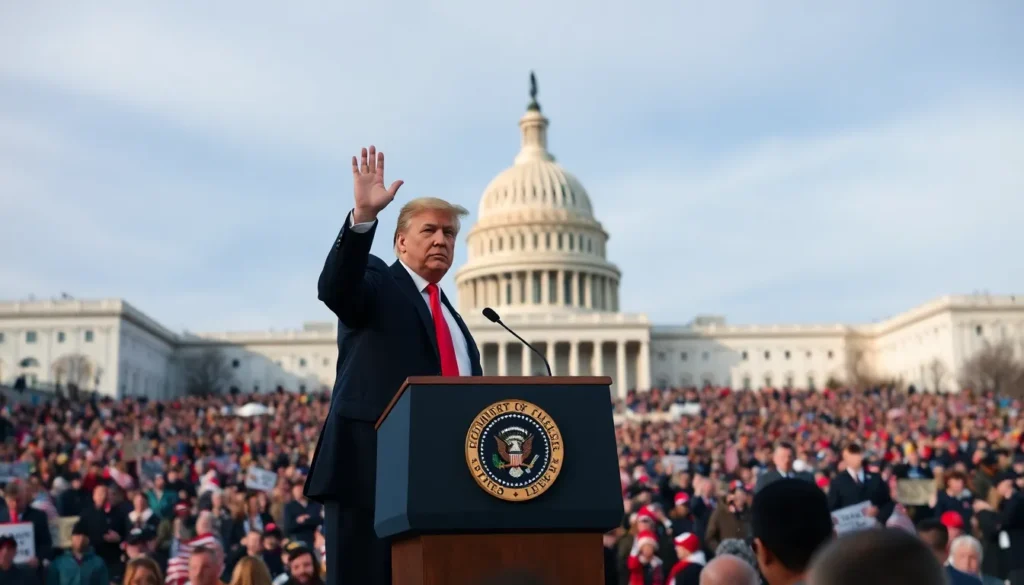Table of Contents
ToggleDonald Trump’s entry into the presidency marked a significant turning point in American politics. Taking office on January 20, 2017, he brought a unique blend of business acumen and unfiltered rhetoric that captivated millions. His unconventional approach challenged the status quo and ignited passionate debates across the nation.
As the 45th president, Trump’s policies and decisions sparked both fervent support and staunch opposition. From tax reforms to immigration policies, his administration aimed to reshape the landscape of the United States. Understanding the timeline and impact of his presidency is crucial for grasping the current political climate and its implications for the future.
Overview of Donald Trump’s Presidency
Donald Trump’s presidency began on January 20, 2017, and spanned until January 20, 2021. Trump, a businessman and television personality, brought a distinct approach to governance, integrating his business background into political leadership. His direct communication style, particularly through social media platforms, resonated with many citizens, allowing him to connect with supporters in unprecedented ways.
Trump’s administration implemented significant tax reforms through the Tax Cuts and Jobs Act of 2017, which aimed to stimulate economic growth by lowering tax rates for individuals and businesses. The act reduced the corporate tax rate from 35% to 21%, encouraging investment and expansion among various industries.
Immigration policy represented another focal point of Trump’s presidency. His administration introduced stricter immigration measures, including the controversial travel ban targeting several predominantly Muslim countries and increased enforcement of immigration laws. These policies sparked substantial debate, reflecting a polarized view on immigration in America.
Trump also prioritized deregulation, particularly in environmental and financial sectors, arguing that reducing regulatory burdens stimulates economic growth. His administration withdrew from the Paris Agreement, a global effort to combat climate change, emphasizing national interests.
The Supreme Court saw significant shifts during Trump’s term, with three appointments that solidified a conservative majority. These appointments influenced key rulings on various issues, including abortion and healthcare.
Trump’s foreign policy established a focus on “America First,” aiming to renegotiate trade agreements such as NAFTA, which he replaced with the United States-Mexico-Canada Agreement (USMCA). His summits with North Korean leader Kim Jong-un marked a notable departure from traditional diplomatic practices.
Overall, Trump’s presidency has made a lasting impact on American politics, shaping the current political landscape and influencing public discourse. Understanding the key aspects of his administration is vital for analyzing ongoing political developments and their implications for the future.
Key Events Leading to Trump’s Inauguration


Donald Trump’s journey to the presidency involved critical milestones that set the stage for his inauguration. Understanding these events provides insight into the political climate leading up to his presidential term.
The 2016 Presidential Election
The 2016 presidential election, held on November 8, showcased a highly contentious race. Trump, representing the Republican Party, faced Democratic candidate Hillary Clinton. Voter turnout reached approximately 60.2%, with Trump securing 304 Electoral College votes against Clinton’s 227. Notably, he lost the popular vote, receiving about 62.9 million votes (46.1%), while Clinton received 65.8 million votes (48.2%). Key battleground states, including Pennsylvania, Michigan, and Wisconsin, swung in Trump’s favor, ultimately determining the outcome and leading to significant electoral shifts in U.S. politics.
Campaign Strategies and Promises
Trump’s campaign strategies focused on appealing to disaffected voters through a message of change. He positioned himself as an outsider capable of disrupting the political establishment. Key promises included tax cuts, the repeal of the Affordable Care Act, and strict immigration enforcement, including a border wall funding plan. His use of social media for direct communication with supporters bypassed traditional media channels, amplifying his message and rallying his base. The campaign’s core themes of “Make America Great Again” resonated strongly, contributing to his electoral success and shaping public perception ahead of his inauguration.
The Inauguration Day: What Happened?
Inauguration Day took place on January 20, 2017, marking the official start of Donald Trump’s presidency. The ceremony occurred at the United States Capitol in Washington, D.C., featuring traditional elements such as the oath of office, the inaugural address, and various performances.
The oath of office was administered by Chief Justice John Roberts. Trump recited the words, affirming his commitment to uphold the Constitution. The event attracted significant attention and an estimated 1.8 million spectators attended, although media reports disputed the crowd size.
Trump delivered a populist inaugural address, emphasizing themes of nationalism and economic revival. He declared, “The forgotten men and women of our country will be forgotten no longer,” signaling a pledge to prioritize U.S. workers and families. His remarks focused on issues such as job creation, security, and a rejection of the political establishment.
The inauguration also included performances from various artists. While some entertainers declined to participate due to political differences, others, including Toby Keith and the Rockettes, performed at the event. The diverse response highlighted the divisive nature of Trump’s election.
The transition of power concluded smoothly, despite the underlying tensions from the election. Trump’s inauguration signified a pivotal moment in American history, with broad implications for domestic and foreign policy moving forward.
Major Policies Implemented During His Presidency
Trump’s presidency saw the implementation of several pivotal policies that influenced both domestic and foreign landscapes. His administration focused on economic reforms, trade adjustments, and foreign relations that sparked widespread discussion.
Economic Policies and Tax Cuts
Trump’s administration enacted the Tax Cuts and Jobs Act of 2017, which reduced federal income tax rates for individuals and corporations. The law lowered the corporate tax rate from 35% to 21%, aiming to encourage investment and drive economic growth. Supporters attributed a surge in stock market performance and increased wages to these tax cuts, while critics argued that the benefits disproportionately favored the wealthy and increased the national deficit.
Additionally, Trump’s economic policy included a focus on deregulation across various sectors. Regulatory rollbacks aimed to stimulate business operations and reduce compliance costs. The Environmental Protection Agency (EPA) saw significant reductions in environmental regulations, prioritizing energy production and job creation over environmental protections. These measures generated debate surrounding their long-term impact on sustainability and public health.
Foreign Relations and Trade Agreements
Trump pursued an “America First” foreign policy, focusing on renegotiating existing trade agreements to favor U.S. interests. A notable example includes the replacement of the North American Free Trade Agreement (NAFTA) with the United States-Mexico-Canada Agreement (USMCA), which aimed to increase U.S. access to Canadian and Mexican markets while supporting American agriculture and manufacturing.
The administration also emphasized tariffs as a tool for addressing trade imbalances. Tariffs on imported steel and aluminum targeted China and other nations, aiming to protect American industries from foreign competition. This approach generated tensions with trading partners, leading to retaliatory tariffs that impacted various sectors.
Trump’s administration also engaged in unprecedented diplomacy with North Korea, attempting to denuclearize the Korean Peninsula through high-profile summits. The meetings represented a shift in U.S. engagement with North Korea, fostering discussions that aimed at a peaceful resolution to longstanding tensions. However, these efforts received mixed evaluations regarding their effectiveness and lasting outcomes.
Public Response and Controversies
Trump’s presidency elicited strong reactions across the political spectrum, highlighting deep social divisions in the United States. Supporters applauded his policies, while opponents criticized his rhetoric and decisions.
Support and Opposition
Support for Trump emerged from various demographics, including working-class individuals and white voters in rural areas, who resonated with his economic promises and anti-establishment stance. His implementation of tax cuts, deregulation, and strict immigration policies built a loyal base. Conversely, opposition arose from many minority groups, urban voters, and progressive politicians who viewed his policies as regressive and divisive. Protests against his travel ban and immigration enforcement highlighted widespread dissatisfaction, demonstrating stark contrasts in public opinion.
Media Coverage and Influences
Media coverage of Trump’s presidency featured extensive analysis, both supportive and critical. Major news outlets often portrayed his administration’s actions through a lens of scrutiny, focusing on controversies like the handling of the COVID-19 pandemic, impeachment, and interactions with foreign leaders. Trump’s frequent use of social media allowed him to bypass traditional media channels, directly engaging with his supporters. This controversial approach altered the media’s landscape, prompting debates over misinformation, bias, and the role of journalism in democracy.




